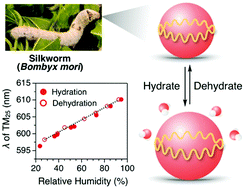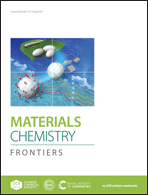Silk fibroin microspheres as optical resonators for wide-range humidity sensing and biodegradable lasers†
Abstract
Biopolymers, which are organic macromolecules produced by living systems, are promising materials in terms of biodegradability and sustainability. However, in the field of optical sensing, most devices or their elements still rely on synthetic inorganic or organic compounds. In this study, we successfully transform pristine silk fibroin (SF), a naturally abundant and eco-friendly material, into discrete, well-defined microspherical particles that function as an active optical resonator for precise moisture sensing over a wide humidity range. The SF self-assembles into microspherical particles upon water-in-oil emulsification. When being photoexcited, the SF microspheres, doped with a fluorescent ionic dye, display whispering gallery mode (WGM) resonant luminescence. Because of their excellent hygroscopic properties, the SF microspheres expand in size as the surrounding humidity is increased, and the WGM resonant peaks exhibit a red shift with a linear relation to the surrounding humidity over a wide humidity range of up to 95 percent relative humidity (%RH) with a sensitivity as high as 187 pm/%RH. Furthermore, the SF microsphere works as a laser resonator upon femto-second pumping. The fully natural microspheres as presented in this work serve as sustainable and environmentally friendly optical resonators and sensors.

- This article is part of the themed collection: 2021 Materials Chemistry Frontiers HOT articles


 Please wait while we load your content...
Please wait while we load your content...